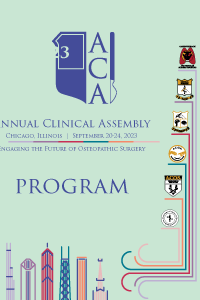General Surgery
Unique Presentation of Adult Ileocecal Intussusception Unveiling a Rare Culprit: A Carcinoid Tumor
- MM
Margaret L. Munz
VCOM-Carolinas
Califon, New Jersey, United States
Primary Presenter(s)
Ileocecal intussusception occurs when a portion of the terminal ileum invaginates into the cecum. Adult cases account for 5% of all intussusception cases and represent 1% of all adult bowel obstructions. While many cases are idiopathic, structural lead points are more commonly observed in adult intussusception compared to pediatric cases where risk factors include infections, Meckel’s diverticulum, and intestinal polyps. Structural obstructions in adults are usually a result of benign or malignant neoplasms, with lipoma being the most common cause of small bowel intussusception (38%), while colonic intussusception primarily arises from malignant lesions (63%), particularly adenocarcinomas and lymphomas. However, in this particular case, a rare metastatic carcinoid tumor originating in the ileum acted as the structural lead point for intussusception. Carcinoid tumors have an incidence rate of 3.56 per 100,000 cases in the United States and account for approximately a third of all small bowel tumors. Although they can be found throughout the gastrointestinal tract, carcinoid tumors are most commonly located in the distal ileum. Therefore, this case represents a unique presentation of adult ileocecal intussusception with obstructive symptoms, all attributed to a carcinoid tumor arising within the ileum.
Methods or Case Description:
A 72-year-old male presents to the emergency department with a chief complaint of abdominal pain. The patient’s medical history was significant for hypertension and hyperlipidemia. The patient also has a surgical history including various orthopedic procedures, right inguinal hernia repair, hemorrhoidectomy, spinal fusion, and dental procedures. The patient has a maternal family history of cancer of unknown origin. On physical examination the patient appeared to be a well-nourished adult male in mild distress experiencing periumbilical abdominal pain. No peritoneal signs were elicited during the exam. A CT scan with contrast performed in the emergency department was consistent with ileocecal intussusception and the patient was subsequently admitted to the hospital for symptomatic management, where conservative observation was employed. Lab work was noncontributory. The patient was observed in the hospital for two days for analgesia and gastric decompression via nasogastric tube. Despite these interventions, follow up X-rays continued to indicate signs of obstruction and the patient remained symptomatic. Two days later the patient underwent an exploratory laparoscopy and subsequent right hemicolectomy with extracorporeal side-by-side anastomosis. Intraoperative examination did not reveal any visible mass or signs of malignancy. The excised specimen, along with associated lymph nodes, was sent for further assessment. The final pathological evaluation identified a metastatic carcinoid tumor originating in the ileum and spreading to the small intestine and colonic mesenteric nodes, ultimately providing a definitive cause for the ileocecal intussusception and subsequent abdominal obstruction.
Outcomes:
Adult intussusception is a rare cause of bowel obstruction in adults, especially those resulting from malignancy as the predominant etiology. In this specific case, the patient presented with intussusception caused by a carcinoid tumor. As the patient did not demonstrate general cancer symptoms prior to the intussusception, this case highlights the importance of maintaining a high index of suspicion for uncommon etiologies.
Carcinoid tumors in the United States are rare neuroendocrine neoplasms that occur in an estimated 3.56 cases per 100,000 people. Carcinoid tumors are the most common small bowel tumor accounting for 20-50% of all small bowel malignancies and are more frequently identified in the ileum. Although they can manifest with symptoms related to hormone production, such as flushing or diarrhea, these tumors can also lead to bowel obstruction and intussusception in adult patients. After an extensive literature review, the incidence of carcinoid tumors as a lead point of intussusception was not found, but there are limited reported cases of such. According to the National Comprehensive Cancer Network (NCCN) guidelines, checking lab values of chromogranin A and 5-hydroxyindole acetic acid (5-HIAA) every 3-6 months may be indicated to monitor for metastatic disease after identification and removal of the tumor. In cases with more aggressive presentations, other treatment options may be considered to assess for carcinoid metastasis.
Conclusion:
This case of adult intussusception caused by a carcinoid tumor underscores the significance of recognizing and considering uncommon etiologies in adult patients presenting with this condition. While adult intussusception is relatively rare compared to its pediatric counterpart, it is vital for healthcare providers to maintain a high index of suspicion for uncommon causes. Early diagnosis and prompt surgical intervention are crucial for achieving favorable outcomes and minimizing complications. Further research is warranted to enhance our understanding of carcinoid-associated intussusception and improve patient care in such cases.

